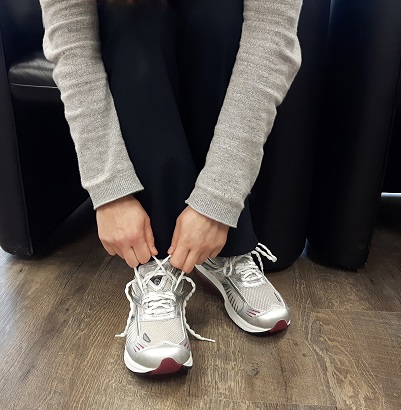
The Proper Shoes for Diabetics
Proper shoes are very important, but it is an especially important consideration for diabetics.
Why are the proper shoes important for diabetics?
Finding the proper shoes for a diabetic is important because of complications that can arise from diabetes. Peripheral neuropathy and compromised blood flow are common complications that can arise. Why this can be a problem, is because small cuts or pressure points can develop into something much worse if not monitored.
Peripheral Neuropathy
Peripheral neuropathy is damage to the nerves, which compromises the sensation to the feet. If this has developed, you may not notice small or large pressure areas that are damaging the feet. When pressure or rubbing develops on a specific area, an individual with normal sensation would consciously or subconsciously avoid the area for protection. Someone with peripheral neuropathy may not avoid the area because the body is not able to recognize the extra pressure by not feeling any pain. If the area is not dealt with, the pressure can build until there is damage to the skin or to other structures in the area.
Compromised Blood Flow
Compromised blood flow to the extremities affects healing. If there is a wound or other injury, blood helps to heal by bringing important cells to the area. With compromised blood flow, healing rates are reduced significantly, which also increases the risk of infection.
Ulcers
Ulcers are a wound that is not healing properly. This can develop because of peripheral neuropathy creating the wound without notice, and compromised blood flow by preventing the healing process.
When ulcers are not treated early and regularly, there is a high chance of infection developing and leading to hospitalization. Once this occurs, there are many cases that have led to an amputation because of an infected ulcer.
Recognizing Areas of Concern
First, how do you recognize when there is a pressure area to be addressed? Look for signs of pressure, which can be a callus (thickened skin), corn (circular type callus) or redness. Make sure to check your feet at least once a day for these signs of pressure. If you are not able to check them yourself, have someone else in your household take a look, or use a mirror. If any of these pressure signs develop, look for the cause of the pressure and deal with it as soon as possible.
Proper Shoes for Diabetics
To prevent these pressures areas from developing, the proper shoes are an important consideration. There are many shoes on the market that can cause pressure in specific areas of the foot. These areas that may seem fine after wearing for a few minutes, can become a large problem after a few hours to many days.
Shoe Fit
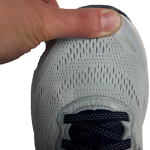
Finding the correct fit of a shoe is very important, and can be easily misjudged. Especially with diabetes, the shoe should not be fitted based solely on the feel. Diabetics may not be able to feel their toe hitting the end of the shoe or if the shoe is too tight around the sides. To find the correct fit, make sure there is a thumb width (~1/2”) from the end of the longest toe and the end of the shoe. Measure this length while standing up because the foot will lengthen when standing versus sitting.
Next, make sure the width is correct. The foot should not be bulging out the sides of the shoe. A good trick when fitting the width, is to take out the original insert inside the shoe and stand on it. The sides of the foot should not be spilling over the sides. Find a shoe brand that has multiple widths as this will allow you to find the correct width for your foot.
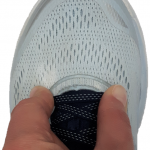
The last area to check is the depth which is the volume inside the shoe. The depth is measured by pinching the top of the shoe at the end of the laces (towards the toes). There should be some movement with the material, otherwise more room in the shoe is needed.
Shoe Properties
Look for shoes that have less seams and more stretchable materials, especially over high-pressure areas. When looking for seams, feel the inside of the shoe for any bumps or ridges that could rub against the foot. Also, make sure the plastic strips are not running over the bunion area or tops of the toes. If you have a more prominent bunion or hammer/clawed toes, stretchable fabric may be a great option around those areas.
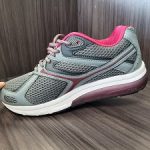 A rocker sole is another great option to take pressure away from the ball of the foot. This rocker sole curves upwards at the toe area to roll the foot when walking.
A rocker sole is another great option to take pressure away from the ball of the foot. This rocker sole curves upwards at the toe area to roll the foot when walking.
Find a shoe with either laces or a Velcro closure. Because the feet can swell throughout the day, these adjustable closures will give you the option of changing the fit depending on how swollen the foot is.
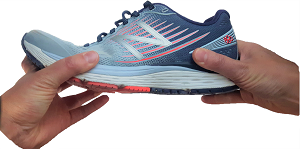
Also, make sure the shoe has the proper support to prevent the foot from moving around and/or collapsing too much. Look for a shoe with a solid sole. Test this by bending the shoe through the middle. A supportive shoe will resist the force of your hands trying the bend the shoe.
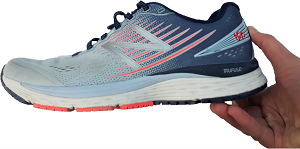
The other area to look at is the heel. The back of the heel should not bend when pressing on it. In some cases, additional support through something like an over the counter insert or custom foot orthotic may be necessary.
For extra help, make sure you are fitted by a store that knows how to fit you properly and has multiple width options.
For more information, feel free to contact us or book an appointment!

You must be logged in to post a comment.